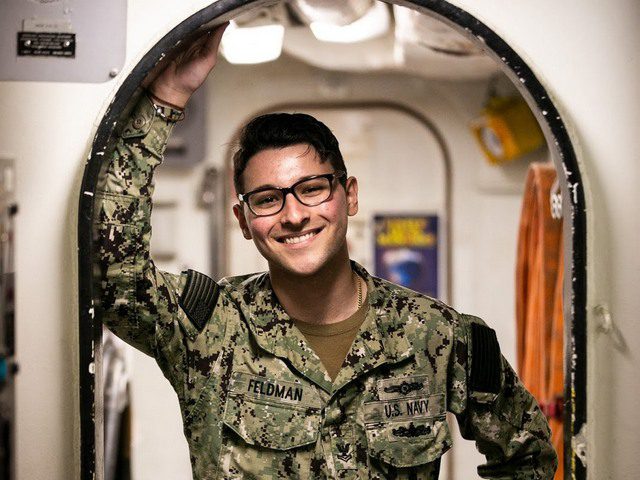
Petty Officer Second Class Samuel Feldman, a native of Miami, was inspired to join the Navy by his dad, who also served in the Navy.
Now, three years later and half a world away, Feldman serves aboard one of the Navy’s most advanced amphibious ships at Fleet Activities Sasebo, patrolling one of the world’s busiest maritime regions as part of U.S. Seventh Fleet.
“It’s the roughest life anyone can have,” Feldman said. “You are away from everything, you have to sacrifice everything and if you are still a good person after years of serving then you have succeeded.”
Feldman, a 2016 graduate of Hialeah Miami Lakes Senior High School, is an intelligence specialist aboard the forward-deployed amphibious assault ship USS Wasp based in Sasebo, Japan.
“My job is to indicate and inform the commander of any threats,” he said.
Feldman credits some success in the Navy to lessons learned in Miami.
“I learned a lot from my dad. I love him to death. He is a super humble guy, assertive but humble, and confident,” Feldman said.
“I wouldn’t be a second class and advanced as fast as I have if it wasn’t for what he has taught me over the years.”
The U.S. Seventh Fleet spans more than 124 million square kilometers, stretching from the International Date Line to the India/Pakistan border; and from the Kuril Islands in the north to the Antarctic in the south. U.S. Seventh Fleet’s area of operations encompasses 36 maritime countries and 50 percent of the world’s population with between 50-70 U.S. ships and submarines, 140 aircraft, and approximately 20,000 sailors.
“It’s like being in a foreign world; I’m out of my comfort zone,” Feldman said. “You see new things every day. It’s all very interesting; you can’t get bored of it.”
With more than 50 percent of the world’s shipping tonnage and a third of the world’s crude oil passing through the region, the United States has historic and enduring interests in this part of the world. The Navy’s presence in Sasebo is part of that long-standing commitment.
“The Navy is forward-deployed to provide security and strengthen relationships in a free and open Indo-Pacific. It’s not just the ships and aircraft that have shown up to prevent conflict and promote peace,” said Vice Adm. Phil Sawyer, commander, U.S. Seventh Fleet. “It is, and will continue to be, our people who define the role our Navy plays around the world. People who’ve made a choice, and have the will and strength of character to make a difference.”
USS Wasp, one of the Navy’s most advanced amphibious ships, is designed to deliver Marines and their equipment where they are needed to support a variety of missions ranging from amphibious assaults to humanitarian relief efforts.
Sailors’ jobs are highly varied aboard USS Wasp. More than 1,000 men and women make up the ship’s crew, which keeps all parts of the ship running smoothly, from handling weapons to maintaining the engines. An additional 1,200 Marines can be embarked.
USS Wasp is capable of transporting Marines and landing them where they are needed using helicopters, vertical takeoff and landing aircraft and other water-to-shore landing craft.
These ships support missions from sea to shore, special operations and other warfare missions. They also serve as secondary aviation platforms. Because of their inherent capabilities, these ships have been and will continue to be called upon to support humanitarian and other contingency missions on short notice, according to Navy officials.
Serving in the Navy means Feldman is part of a world that is taking on new importance in America’s focus on rebuilding military readiness, strengthening alliances and reforming business practices in support of the National Defense Strategy.
A key element of the Navy the nation needs is tied to the fact that America is a maritime nation, and that the nation’s prosperity depends on the ability to operate freely on the world’s oceans. More than 70 percent of the Earth’s surface is covered by water; 80 percent of the world’s population lives close to a coast, and 90 percent of all global trade by volume travels by sea.
“Our priorities center on people, capabilities and processes, and will be achieved by our focus on speed, value, results and partnerships,” said Secretary of the Navy Richard V. Spencer. “Readiness, lethality and modernization are the requirements driving these priorities.”
There are many ways for sailors to earn distinction in their command, community, and career. Feldman is most proud of being able to handle every situation he has been given in the Navy and advancing so quickly.
“I have three warfare qualification pins and I’m a second class in only three years, which is unheard of,” Feldman said. “I’m just glad that I’m able to stay focused so I can learn more.”
As a member of one of the U.S. Navy’s most relied upon assets, Feldman and other Sailors know they are part of a legacy that will last beyond their lifetimes, contributing to the Navy the nation needs.
“It means the world to me to serve in the Navy; I’m so proud,” Feldman said. “I wouldn’t trade it in for anything.”






